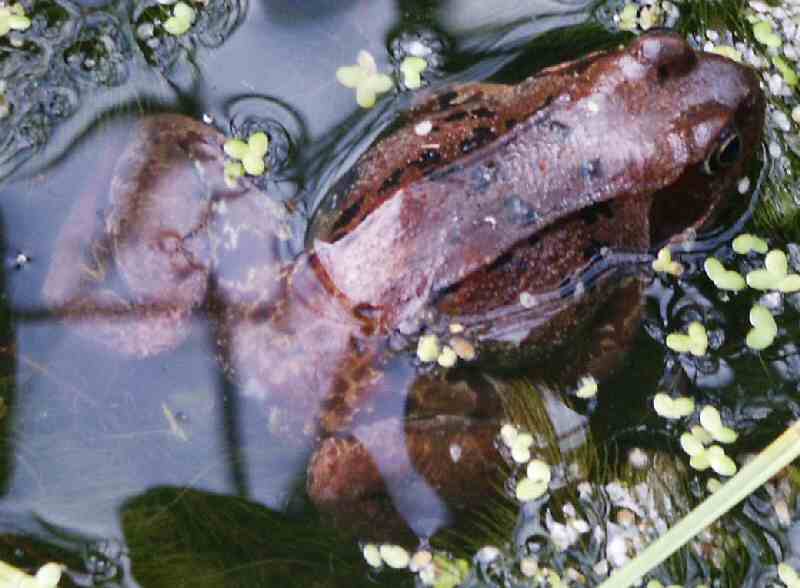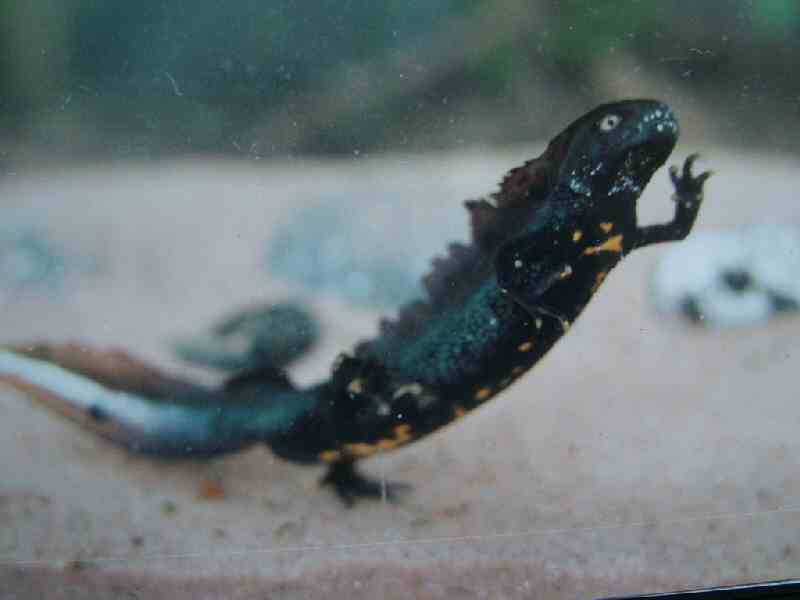 |
 |
How Common are Red frogs in England?: |
| Author | Message |
|
Cavy Member Joined: 22 Apr 2006 No. of posts: 5 View other posts by Cavy |
Posted: 13 Jul 2006 Sorry if this has been covered (did try to search, but was surprised I came up with nothing). We have a very red frog in our pond. She has been like this for months, although I think she may be getting darker red (since I first noticed her a few months ago). I don't think it's Red Leg (a bacterial infection, apparently), because she's red all over & seems ok other than being dark brick red, and none of their other frogs have been found dead (or red). How uncommon is this? She (or he) is a full adult. We live in north Norfolk. |
|
Jimpklop Senior Member Joined: 23 May 2006 No. of posts: 200  View other posts by Jimpklop |
Posted: 13 Jul 2006 Hi Cavy Frogs aren't a strong point of mine I'm trying hard to learn about these aspects. What size is the Housing? How many frogs are housed there? Could you get a picture? Thanks James Im Craving Adder's(www.jimpklop.moonfruit.com) |
|
GemmaJF Admin Group Joined: 25 Jan 2003 No. of posts: 2090 View other posts by GemmaJF |
Posted: 13 Jul 2006 Well Cavy, reports of oddly coloured common frogs (red/black/yellow/orange etc) are now fairly common particularly in urban areas. Piccy would be interesting to see. Gemma Fairchild, Independent Ecological Consultant |
|
Cavy Member Joined: 22 Apr 2006 No. of posts: 5 View other posts by Cavy |
Posted: 15 Jul 2006 Sorry everyone, I'm so bad at this I can't even figure out how to add a new reply to this thread, but it seems I can edit this post? So I've now got a picture uploaded. Big Update is that the frog has died, so maybe she was poorly with something (it looked like she had a fungus or rot on her bottom, as you can almost see in this pic). So maybe she was poorly. But she was quite mature (not a subadult for sure). But rest of frogs still seem ok (if suffering from pond shrinkage in this heat wave). Pond size: it's a half-circle shape with radius of about 1.5m, so not small. We live on the edge of a market town. We live right in front (downwind) from a field growing barley that has been sprayed -- could chemicals cause the frog to be so red? |
|
mynewt Member Joined: 18 Jul 2006 No. of posts: 12 View other posts by mynewt |
Posted: 19 Jul 2006 Hi Gemma and other Raukers After having followed the various threads for a while on the site I thought it was time to take the plunge myself.. This is about the apparent increase in oddly coloured (common) frogs, especially in gardens. Apart from simple observer bias, I wonder if this has little to do with inbreeding and genetic drift (if so, wouldn't most of the frogs around one breeding site be expected to show the same 'odd' colour ?) and more to do with increased survival of odd coloured frogs in the benign environment of the garden. Most, if not all, of these odd coloured frogs are being observed as adults / subadults. Maybe it's just that the same fraction of odd coloured froglets metamorphose in the wild and in suburbia, but the higher survival rate for odd coloured frogs can be greater in gardens due to a lack of predation - especially by colour sensitive predators like herons (which do visit garden ponds, I know, but can't be as significant in this environment than in the 'wild'). To test this idea, it would be necessary to count the proportion of odd coloured froglets at metamorphosis in wild and garden populations, and see if there were differences in a) the proportions of odd coloured froglets in the 2 kinds of habitat and b) whether survival rates of odd coloured frogs were different post-metamorphosis in the 2 areas. Has anyone done any work to test this ? Any thoughts welcome. I'll try to post a pic of a lovely near-black common frog from a site in Islington, north London, which I saw last week - as well as a similarly coloured crested newt from a few years back, to show that the same odd colours can happen in suburban GCN too.. Cheers Mynewt |
|
GemmaJF Admin Group Joined: 25 Jan 2003 No. of posts: 2090 View other posts by GemmaJF |
Posted: 19 Jul 2006 Hi Mynewt, I've seen near black frogs in Haringey. One interesting obs I made was when clearing an isolated courtyard population at an inner London school. Firstly, the pond had to go because of insurance reasons. The population could be assumed to be 100% isolated. The interesting bit was that all the youngest frogs looked 'normal' only as you have stated, the sub-adult and adult frogs showed colour aberration and rounded snouts. So counting odd froglets may not provide any information as it appears the symptoms occur in later life. There is no doubt in my mind that these odd frogs are mostly centered around garden populations, perhaps pointing to genetic factors, however I have also observed the occasional odd frogs in the wider countryside in the last couple of years showing similar characteristics. (colour aberration, rounded snouts, unusual gait, generally odd looking). Certainly common frogs visiting our garden pond from the wild look like the ones I remember from childhood, quite different to the distinctly odd ones I see on call outs in more suburban gardens. I wonder if it would be worth close observation of the development of frogs from these populations? Certainly something is not right but it appears mostly there is little interest in the issue. PS Cavy, you can upload images directly to the forum using the Gemma Fairchild, Independent Ecological Consultant |
|
mynewt Member Joined: 18 Jul 2006 No. of posts: 12 View other posts by mynewt |
Posted: 19 Jul 2006 Thanks for the reply Gemma. Your point about the froglets not yet showing their 'true colours' is a good one. I guess what I meant was that odd frogs - colour, shape etc - perhaps even the odd extra leg ! - might be no more common to start off with in gardens than in the wild, but that relaxed selection in gardens might allow them to persist for longer than in the 'tangled bank' of Darwinian realities out in the wild. As a result, alleles which could be maladaptive in the wild are not ruthlessly selected against and become more prevalent in the garden habitats. This is a separate although not mutually exclusive explanation from that offered by Trevor Beebee in which genetic drift (ie neutral selection) is held responsible for odd colours being more commonly observed in suburban than wild frog populations. Mynewt PS In my limited experience, 'round nosed' common frogs are very often older ones, and I would agree that this often correlates with odd colours and patterns - perhaps some frogs get more striking patterns as they age ? |
|
mynewt Member Joined: 18 Jul 2006 No. of posts: 12 View other posts by mynewt |
Posted: 19 Jul 2006 Here are the odd frog and GCN from London; apologies for the low quality of images, especially the GCN which is a photo of a photo.. I thought the frog had a particularly black slimy mud on it when first seen but in fact that black colour is the frog's own  Mynewt |
|
Caleb Forum Coordinator Joined: 17 Feb 2003 No. of posts: 448 View other posts by Caleb |
Posted: 19 Jul 2006 [QUOTE=mynewt]In my limited experience, 'round nosed' common frogs are very often older ones[/QUOTE] I've certainly found that larger common frogs are more likely to be 'round nosed'. I also have a suspicion that most 'round nosed' frogs are female... |
|
mynewt Member Joined: 18 Jul 2006 No. of posts: 12 View other posts by mynewt |
Posted: 19 Jul 2006 Nice to see this illustration of at least one 'odd' / bright female common frog going back to the turn of the last century, from Boulanger's book Mynewt |
|
GemmaJF Admin Group Joined: 25 Jan 2003 No. of posts: 2090 View other posts by GemmaJF |
Posted: 20 Jul 2006 The rounded snouts I've seen on 'odd' frogs have included sub-adult individuals, perhaps not a clear description, though I am not confusing it with the usual appearance of adult female common frogs. There are other symptoms also including the look of the membranes surrounding the eye that mark some of the colour abarrent frogs apart in my mind to 'normal' frogs. The Trevor Beebee theory has a lot of merit, I wonder if counting odd coloured juveniles is not going to work, what other options are there to carry out field work to investigate this? Gemma Fairchild, Independent Ecological Consultant |
|
mynewt Member Joined: 18 Jul 2006 No. of posts: 12 View other posts by mynewt |
Posted: 20 Jul 2006 I guess you'd have to capture large numbers of froglets from wild vs suburban populations and raise them for a while til they show their true colours - not an easy thing to do ! If I'm right, there should be no significant difference between odd colours in frogs derived from wild areas and those from suburban areas, provided they're raised in identical conditions. With reference to Trevor Beebee's work, I'm sure I remember reading somewhere that he did a genetic analysis of urban frogs looking for heterozygosity at specific gene loci, as an indication of inbreeding, and found more in urban than rural populations. On the other hand, even an occasional input of fresh genes from a frog down the road can boost the variation in a population for a long while. This raises the whole controversy of spawn swapping - inbreeding dangers vs red leg etc once again, of course. |
|
GemmaJF Admin Group Joined: 25 Jan 2003 No. of posts: 2090 View other posts by GemmaJF |
Posted: 20 Jul 2006 My problem with this is there seems to be more to it. The Boulanger frog appears no different to many observable in wild populations, the 'odd' frogs seem to me different in many aspects to more 'normal' healthy specimens I observe. I guess I could say it is a bit like seeing a rabbit with the last stages of myxomatosis, you don't need to know what caused it to instinctively feel something is 'wrong' with the animal. Gemma Fairchild, Independent Ecological Consultant |
|
mynewt Member Joined: 18 Jul 2006 No. of posts: 12 View other posts by mynewt |
Posted: 20 Jul 2006 I agree Gemma - truth is, I just like the Boulanger illustration - there is definitely something more unusual than just an orange-ish female frog situation in some of these urban frogs. But my main point is simply that I think it might be worth investigating the hypothesis that this sort of maladaptive trait might be less selected against in the cosseted world of the back garden than in the rough and tough of 'the wild'. |
|
GemmaJF Admin Group Joined: 25 Jan 2003 No. of posts: 2090 View other posts by GemmaJF |
Posted: 20 Jul 2006 I think it may well be, not sure of the raising lots of frogs, being perhaps one of the worst captive subjects I can imagine! I wonder though if a field measurements/notes could be collected? If it could be defined which traits were 'odd' and which normal perhaps we could move towards seeing if it does occur generally more in garden populations? I can certainly sample some population of 100+ wild frogs that I think would generally return 'normal' results from past observations.. could this work with RAUK members also keeping an eye out for the 'odds' PS I liked the Boulanger illustration, thanks for sharing it Gemma Fairchild, Independent Ecological Consultant |
|
mynewt Member Joined: 18 Jul 2006 No. of posts: 12 View other posts by mynewt |
Posted: 21 Jul 2006 Good idea Gemma; one for the spring, perhaps - we could make a note of 'odd colours' in breeding frogs at 'wild' vs 'garden' sites, when there is a large sample size. Of course it wouldn't tell us whether if there IS a significant difference whether this is due to inbreeding and genetic drift, or less natural selection against odd colours in suburbia, or a combination of both. That would then need the tricky follow-up of raising loads of froglets in netted enclosures - MSc project anyone ? And, as you say, there would be the problem of accurately defining what we mean by 'odd' colours and 'the wild' vs 'suburbia / gardens'; anyway, I'll try to do some work next spring - something to look forward to while we're all roasting at the moment.. |
|
Cavy Member Joined: 22 Apr 2006 No. of posts: 5 View other posts by Cavy |
Posted: 21 Jul 2006 Woops! I've edited my previous post to now show pic of my red frog (who is sadly now deceased). |
|
Deano Senior Member Joined: 23 Aug 2005 No. of posts: 133 View other posts by Deano |
Posted: 25 Jul 2006 For what it's worth when I visited Skomer Island a couple of years back, I noticed all the toads there were brick red. Could these localized colour variations be due to a local food source? Perhaps a particular mineral gets into the food chain. Like the small shrimp that flamingoes eat and which gives them their pink colouration. Deano Better to be lucky than good looking. |
|
Caleb Forum Coordinator Joined: 17 Feb 2003 No. of posts: 448 View other posts by Caleb |
Posted: 25 Jul 2006 The shrimp/ flamingo thing is due to carotenoids in the shrimp (which they themselves get from the algae they eat). There are amphibians which change colour according to carotenoids in their diet. Fire-bellied toads are the most well-known example- their belly colour is only red if they've got a carotenoid-rich diet, otherwise it's yellow. Belly colour of crested newts and alpine newts is also dependent on the amount of carotenoids in their diet. This is because of a particular kind of pigment cell that accumulates carotenoids. If common frogs have these cells in the skin on their back, then they should change colour in the same way. This would be quite easy to test- just rear young frogs on a carotenoid-rich diet, and see if they end up redder than those on a normal diet. The easiest way to make a carotenoid-rich diet would be to feed carotenoid preparations (these are available from bird food suppliers) to the livefood the frogs are fed on. |
|
mhows Member Joined: 27 Feb 2006 No. of posts: 19 View other posts by mhows |
Posted: 27 Jul 2006 There were large numbers of brick red froglets at Tichwell RSPB (Norfolk) reserve at the weekend, in the the woodland between the car park and visitors centre.
Mark |
- How Common are Red frogs in England? |